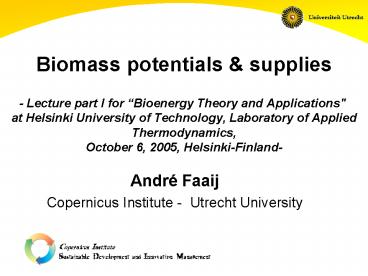Biomass potentials - PowerPoint PPT Presentation
1 / 39
Title:
Biomass potentials
Description:
... demand and international supply chains create unique opportunities for biomass ... rain fed rain fed including irrigation. Total NS land. Total NS land ... – PowerPoint PPT presentation
Number of Views:108
Avg rating:3.0/5.0
Title: Biomass potentials
1
Biomass potentials supplies- Lecture part I
for Bioenergy Theory and Applications" at
Helsinki University of Technology, Laboratory of
Applied Thermodynamics, October 6, 2005,
Helsinki-Finland-
- André Faaij
- Copernicus Institute - Utrecht University
2
Contents part I - IV.
- Biomass potentials, from global to regional
supplies. - Conversion technologies
- Logistics, scaling issues, chain performance and
optimisation. - Greenhouse gas balances, impacts and
sustainability criteria
3
Why biomass?
- Renewable
- Versatile
- Low(er) cost
- Widespread
- Potential
- external
- benefits()
4
Renewable energy in the EU
Total primary energy consumption EU-15 60,800 PJ
5
Electricity from renewables EU-15
6
Development over time
- National programmes predominate (e.g. over 80 of
RDD funds) - Complemented by EC role of EC growing stronger.
- Since 80-ies RDD programmes
- Policy papers (white green) targets.
- Directives (Electricity, Fuels)
7
Results
- Heat In 1990 the production of heat from biomass
1500 PJth to over 1800 PJth in 1999 (2 per
year). - Electricity 54 PJe in 1990 to 166 PJe in 1999
(9 per year). - Biofuels Currently 25 PJfuel.
- Biodiesel80 ktonne in 1993 to 780 ktonnes in
2001. (Germany and France). - Ethanol 48 up to 216 ktonne in the same period.
(France, Spain and Sweden)
8
Future worlds energy supply(combined with 80
reduction of GHG-emissions)
Courtesy of IIASA
Courtesy of Shell
9
energy consumption
population
trade
future land use patterns
biotechnology
POTENTIAL FOR BIO-ENERGY?
GDP
agricultural system irrigation, breeding,
mechanization, chemicals
agricultural policy
land productivity
10
Key elements for assessing future bioenergy
potentials (bottom-up approach)
Source Smeets, Faaij 2004
11
Global land surface and main land use categories
12
Potential spread in the global demand for food
(2050)
13
(Energy) efficiency of food production world
wide(Wirsenius - Chalmers University, Sweden)
14
B1-2010
Source Hoogwijk, Faaij 2004
Integrated assessment modelling using IMAGE
(RIVM) for assessing land-use and production
potentials of biomass for energy
15
B1 2020
Source Hoogwijk, Faaij 2004
16
B1 2030
Source Hoogwijk, Faaij 2004
17
B1 2040
Source Hoogwijk, Faaij 2004
18
B1 2050
Source Hoogwijk, Faaij 2004
19
A2 2050
Source Hoogwijk, Faaij 2004
20
A1 2050
Source Hoogwijk, Faaij 2004
21
B2 2050
Source Hoogwijk, Faaij 2004
22
B1 2050
Source Hoogwijk, Faaij 2004
23
Basics energy crop options (EU)
24
Miscanthus - different genotypes
C4 photosynthetic pathway
Miscanthus sacchariflorus
Miscanthus x giganteus
Miscanthus sinensis hybrid
Miscanthus sinensis
25
Bioenergy production potential in 2050 for
different scenarios
Source Smeets, Faaij 2004
Potential Oceania 4-6 times projected primary
energy use
26
Global cost-supply curve for energy crops for
four scenarios for the year 2050
Source Hoogwijk, Faaij, 2004
27
Overall picture 2050
28
Essentials of future global biomass
availability...
- Major contribution of bio-energy to global energy
supply possible. - But major transitions required to exploit
potentials. - Improved food production systems rate of
deployment in DCs are essential. - Use of marginal/degraded land biomaterials.
- (Net) biomass supply per region strongly
determined by local factors large differences
between regions.
29
Phases in bio-energy use and market development
- Waste treatment and process residues use on
site, low costs. - Local use of (more expensive) forest and
agricultural residues some infrastructure
development. - Regional biomass markets, larger scale
utilisation, increasingly complex logistics
supportive policies needed. - National markets with complex set of suppliers
and buyers often increased availability. - Increasing scale, cross-border flows role for
cultivated biomass bilateral activities. - Global commodity market pricing mechanisms
complex interlinkages with existing markets
(food, forestry, feedstocks)?
30
International bio-energy markets developing fast
- Growing bio-energy demand and international
supply chains create unique opportunities for
biomass producing regions. - Solid biofuels trading develops in bilateral
setting (Canada, Russia, agricultural residues)
bio-ethanol entered first phases commodity market
trading wild west phase - Overexploitation should be avoided and fairtrade
principles implemented. - www.fairbiotrade.org (IEA Task 40 on Sustainable
International Bio-energy Trade).
31
Biomass potentials in CEEC Main characteristics
of scenarios
32
Amount of available land (in 1000 ha) on country
level for energy crop production for different
scenarios
33
Amount of available land (in 1000 ha) in Poland
for energy crop production for different
scenarios
20000
Land suitability
Extensive
17500
mMS (marginally suitable)
MS (moderately suitable)
15000
S (suitable)
VS (very suitable)
12500
1000 ha
10000
7500
5000
2500
0
V1
V2
V3
V4
V5
Scenarios
34
Variation in total available land (and NS land)
for crop production between different production
systems
1) Low input system, 2)
Intensive system, 3) Intensive system,
rain fed
rain fed including
irrigation
Land available for energy crop production
Land required for food production
Total NS land
Total NS land
Total NS land
35
Land available for the production of energy crops
in all CEEC in 2030in 1 000 000 ha
V1 V2 V3 V4 V5
36
Biomass potential on country level (in EJ). Sum
of residues, surplus forest and energy crops,
energy crop is willow. The lines in the graphs
show the current final energy consumption on
country level in EJ for the year 2000 from DG
Tren (2003).
37
Cost assessment
38
Production costs for poplar
Total production costs, differentiated to cost
items, in Poland for poplar production in / ha
yr and / GJ HHV for different scenarios and
land suitability types.
39
Cost-supply curve for all CEEC energy crop
willow































